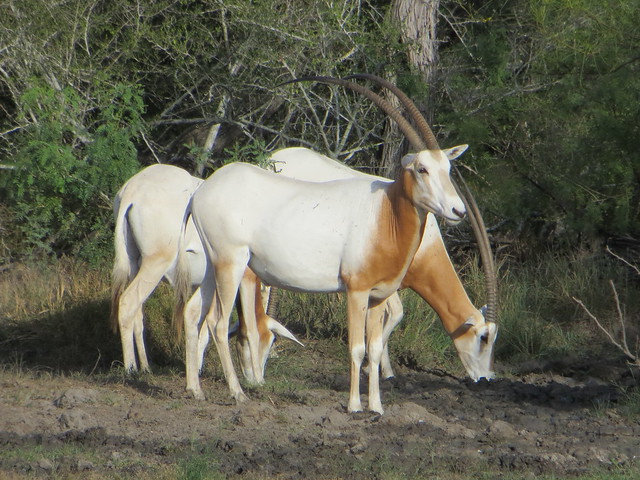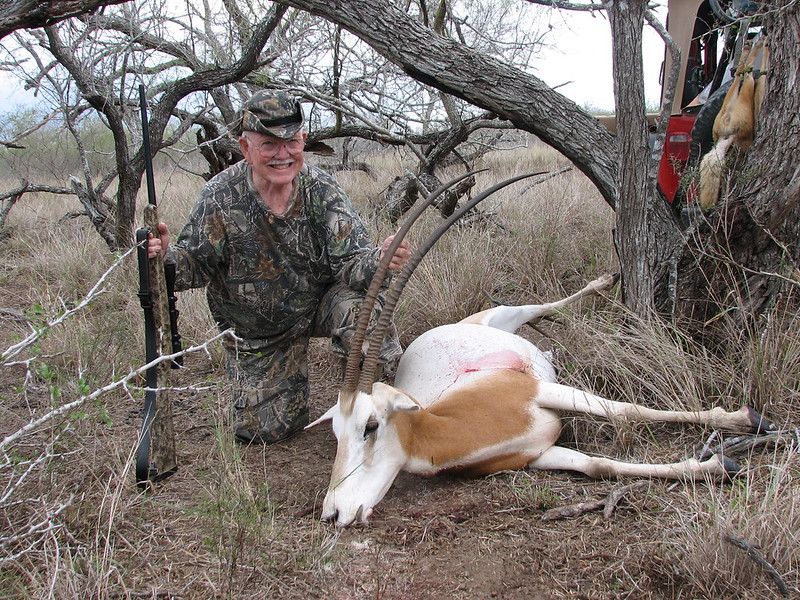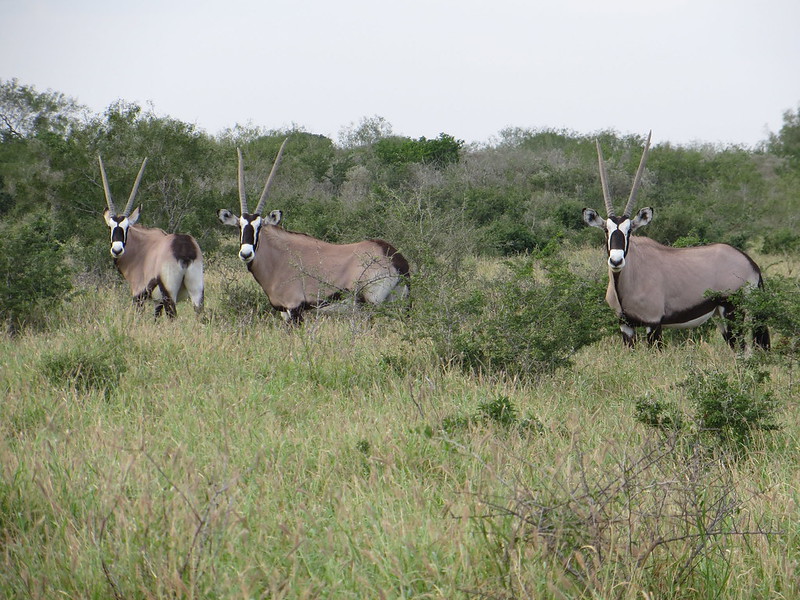Scimitar Horned Oryx, considered extinct in their native desert habitat of North Africa, have made a remarkable comeback on a number of ranches in Texas where the species flourish in spite of the efforts of “environmentalists” such as Priscilla Feral, President of Friends of Animals. Feral states that she would rather see the Scimitar Horned Oryx extinct than to see it hunted in Texas (watch video below).
CBS Sixty Minutes Segment on Scimitar Horned Oryx
Unfortunately the U. S. Fish & Wildlife Service bowed to pressure from Ms. Feral and her backers and it is now necessary for landowners to obtain a Cites permit to raise the animals and issue Cites tags to anyone who harvests one. Furthermore, as with any government bureaucracy, there are many i’s to dot and many t’s to cross in order to comply with all the regulations. This resulted in the slaughter of many of these beautiful animals since smaller operations could not afford to hire attorneys or justify the red tape and expense in order to maintain a small herd on their ranches.
Enough of the background and politics, the Scimitar Horned Oryx, these remarkable animals, as previously stated, were native to the deserts of north Africa but are currently considered extinct.
According to Wilkipedia, the male will weigh between 310 and 460 pounds, standing about 40” at the shoulder. The female ‘s weight will be between 200-300 lbs. The male’s horns are a bit heavier and, usually shorter than the female’s but are not a reliable means of determining sex.
They are uniquely suited to extreme desert environments and can survive up to 9 months without water loss from urination, deriving all they need from the food they eat. Their body temperature can reach 117* before beginning to perspire in order to minimize their need for water.
Scimitars are excellent table fare, right up there with prime beef, Eland and Nilgai.
Since they are herd animals, usually forming groups of 40 or so and up to 100 animals, they are quite challenging to hunt. Stalking within a couple hundred yards with up to 200 eyes watching can be a lot of fun, but be prepared to get “busted” with great regularity.

Last week, I had one female Oryx on the ticket and we drove to hunting camp w/jeep in tow. On the way to camp, we drove past a herd that approached 100 animals which surprisingly lounged in the shade and watched us pass without spooking. Since these had been hunted for the past month, they usually see a vehicle and take off for heavy cover.
We proceeded to camp, unloaded the jeep off the trailer and settled our gear into the bunk house. An hour or so later we headed back out and were surprised to find the herd had not spotted the jeep and was just beginning to stir from their mid-day “siesta”.
Unfortunately, I had left my camera at home, so most pictures were taken before or after this hunt.
In the picture below, the Oryx had been bedded in the shade of the mott of mesquite on the left, (indicated in white) past the cattle guard. My first thought had been, if I could slip up to the cattle guard which ranged 290 yards from our position, I might be able to get a shot, but the herd ranged 590 yards and that would put me 300 yards from the closest animal; a bit farther than I would like.

They were just starting to move to the right (strung out along the yellow dotted line), toward a stand of weesatch trees on the flat across the road. (Weesatch is a favorite browse of the Oryx.) Green dot indicates end of a strip of brush which could provide a route we could use to approach (hopefully undetected) within 150 yards of the herd from the downwind side if the Oryx continued on present course and everything else worked as planned. (Blue arrow indicates wind direction.)

While a 300 yard shot is not beyond my comfort zone, determining the sex of an Oryx at that distance w/10x binoculars is! I am uncomfortable with anything beyond 200 yards and prefer to get closer than that, as the only reliable way to be sure if the animal is a bull or a cow is to get a look at the plumbing.
To illustrate the degree of difficulty, the front animal in the picture below is a bull (can you see the plumbing? Hint, it is right above the right ear of the smaller animal just behind him.) and the one on the right happens to be a cow.

This picture also illustrates the fact that the bull’s horns are usually heavier than the cow’s, but I don’t trust this to be a reliable method of determining sex.
So, ruling out the possibility of a direct approach, I chose to back up and drive three or four miles around the herd and try an approach from behind the tree line beyond, indicated by the green dot seen at upper right hand corner of the first photo. This would also have the benefit of being in the (current) direction of movement of the herd. An added benefit is that it was directly downwind of the herd. Lots of if’s, but it just might work.
Twenty or thirty minutes later, we parked the jeep and started easing through the brush to see if our herd was still on course. It was! The leading edge of the herd was also within my comfort zone of our mott as predicted, thanks to the rangefinder. Now, all we need to do is ease through the brush to a point which will provide an opening through which we can shoot and then identify a cow.
We thought we had been spotted twice by the herd bull when he stared in our direction. Each time he raised his head and stared, at least 15-20 others would followed suite. Fortunately, when we froze, his attention would wander and the herd would eventually go back to grazing.
I finally reached a tree surrounded by ground cover which opened a 15* field of fire (after quietly breaking off a couple of small limbs). Did I mention that Oryx sight is outstanding and their nose and ears are not too shabby, either?
One problem with working a herd that large is getting the proper sex in the clear as there is almost always one or more animals in line with the one you have chosen. After identifying the cow that I wanted, the trick was to get a clear shot at her as she was in front of three other animals and others were moving up in a manner that would block the shot.
Just as I though I would have to find another candidate, she stepped clear and the 200 gr. NST from my .338 Win. Mag. did its job; a fitting climax to a memorable hunt that played out exactly as planned.

Regards,
hm

CBS Sixty Minutes Segment on Scimitar Horned Oryx
Unfortunately the U. S. Fish & Wildlife Service bowed to pressure from Ms. Feral and her backers and it is now necessary for landowners to obtain a Cites permit to raise the animals and issue Cites tags to anyone who harvests one. Furthermore, as with any government bureaucracy, there are many i’s to dot and many t’s to cross in order to comply with all the regulations. This resulted in the slaughter of many of these beautiful animals since smaller operations could not afford to hire attorneys or justify the red tape and expense in order to maintain a small herd on their ranches.
Enough of the background and politics, the Scimitar Horned Oryx, these remarkable animals, as previously stated, were native to the deserts of north Africa but are currently considered extinct.
According to Wilkipedia, the male will weigh between 310 and 460 pounds, standing about 40” at the shoulder. The female ‘s weight will be between 200-300 lbs. The male’s horns are a bit heavier and, usually shorter than the female’s but are not a reliable means of determining sex.
They are uniquely suited to extreme desert environments and can survive up to 9 months without water loss from urination, deriving all they need from the food they eat. Their body temperature can reach 117* before beginning to perspire in order to minimize their need for water.
Scimitars are excellent table fare, right up there with prime beef, Eland and Nilgai.
Since they are herd animals, usually forming groups of 40 or so and up to 100 animals, they are quite challenging to hunt. Stalking within a couple hundred yards with up to 200 eyes watching can be a lot of fun, but be prepared to get “busted” with great regularity.

Last week, I had one female Oryx on the ticket and we drove to hunting camp w/jeep in tow. On the way to camp, we drove past a herd that approached 100 animals which surprisingly lounged in the shade and watched us pass without spooking. Since these had been hunted for the past month, they usually see a vehicle and take off for heavy cover.
We proceeded to camp, unloaded the jeep off the trailer and settled our gear into the bunk house. An hour or so later we headed back out and were surprised to find the herd had not spotted the jeep and was just beginning to stir from their mid-day “siesta”.
Unfortunately, I had left my camera at home, so most pictures were taken before or after this hunt.
In the picture below, the Oryx had been bedded in the shade of the mott of mesquite on the left, (indicated in white) past the cattle guard. My first thought had been, if I could slip up to the cattle guard which ranged 290 yards from our position, I might be able to get a shot, but the herd ranged 590 yards and that would put me 300 yards from the closest animal; a bit farther than I would like.

They were just starting to move to the right (strung out along the yellow dotted line), toward a stand of weesatch trees on the flat across the road. (Weesatch is a favorite browse of the Oryx.) Green dot indicates end of a strip of brush which could provide a route we could use to approach (hopefully undetected) within 150 yards of the herd from the downwind side if the Oryx continued on present course and everything else worked as planned. (Blue arrow indicates wind direction.)

While a 300 yard shot is not beyond my comfort zone, determining the sex of an Oryx at that distance w/10x binoculars is! I am uncomfortable with anything beyond 200 yards and prefer to get closer than that, as the only reliable way to be sure if the animal is a bull or a cow is to get a look at the plumbing.
To illustrate the degree of difficulty, the front animal in the picture below is a bull (can you see the plumbing? Hint, it is right above the right ear of the smaller animal just behind him.) and the one on the right happens to be a cow.

This picture also illustrates the fact that the bull’s horns are usually heavier than the cow’s, but I don’t trust this to be a reliable method of determining sex.
So, ruling out the possibility of a direct approach, I chose to back up and drive three or four miles around the herd and try an approach from behind the tree line beyond, indicated by the green dot seen at upper right hand corner of the first photo. This would also have the benefit of being in the (current) direction of movement of the herd. An added benefit is that it was directly downwind of the herd. Lots of if’s, but it just might work.
Twenty or thirty minutes later, we parked the jeep and started easing through the brush to see if our herd was still on course. It was! The leading edge of the herd was also within my comfort zone of our mott as predicted, thanks to the rangefinder. Now, all we need to do is ease through the brush to a point which will provide an opening through which we can shoot and then identify a cow.
We thought we had been spotted twice by the herd bull when he stared in our direction. Each time he raised his head and stared, at least 15-20 others would followed suite. Fortunately, when we froze, his attention would wander and the herd would eventually go back to grazing.
I finally reached a tree surrounded by ground cover which opened a 15* field of fire (after quietly breaking off a couple of small limbs). Did I mention that Oryx sight is outstanding and their nose and ears are not too shabby, either?
One problem with working a herd that large is getting the proper sex in the clear as there is almost always one or more animals in line with the one you have chosen. After identifying the cow that I wanted, the trick was to get a clear shot at her as she was in front of three other animals and others were moving up in a manner that would block the shot.
Just as I though I would have to find another candidate, she stepped clear and the 200 gr. NST from my .338 Win. Mag. did its job; a fitting climax to a memorable hunt that played out exactly as planned.

Regards,
hm







